Is it conceivable that there could be an island of socialism in the belly of a capitalist state? It was always difficult enough to believe that there could be “socialism in one country,” but the claim that a local state subjected to the constitution and financial constraints imposed by an increasingly authoritarian neoliberal regime seems a desperate fantasy, or, perhaps, a necessary connection to the idea that things could be different, otherwise, that another world is possible. This is one of the ways that Keralam functions for the left in India, as grounds for hope, and as a space of limited progress in quite specific cultural-political-historical conditions.
The Keralam State Legislative Assembly voted unanimously to change the name of the state from “Kerala” to “Keralam” last year, the name by which this part of India has been known in the main language, Malayalam, since 1956. This could be seen as a local assertion of identity of a state that pits itself against the Narendra Modi regime, activists proud that it was a place in which Modi’s neoliberal and viciously anti-Muslim Bharatiya Janata Party (BJP) had never won a national seat. That was a record broken as Modi, weakened at a national level, unexpectedly took a Lok Sabha seat in the 2024 elections. The CPI(M) is still in control of Keralam, but the BJP poses a threat to the socialist project here.
Keralam – the name which translates either as “The land of the coconuts” or “The land of the Chera Kings” and which is marketed as “God’s own country” – lies on the south-west coast of India, with the state of Karnataka to the north and Tamil Nadu to the east. The 1956 States Reorganisation Act combined four local states; South Canara which had been annexed by the East India Company at the end of the eighteenth century; the former Kingdom of Kochi for which the port of Cochin was a major port, the Kingdom of Travancore to the south which combined with Kochi briefly before being integrated into Keralam, and which is now the location of the state capital Thiruvananthapuram or “Trivandrum” for short; and the Malabar district which had been governed as part of Bombay, and then Madras under English rule, and for which “Calicut,” now known as Kozhikode, was the administrative headquarters.
Material culture
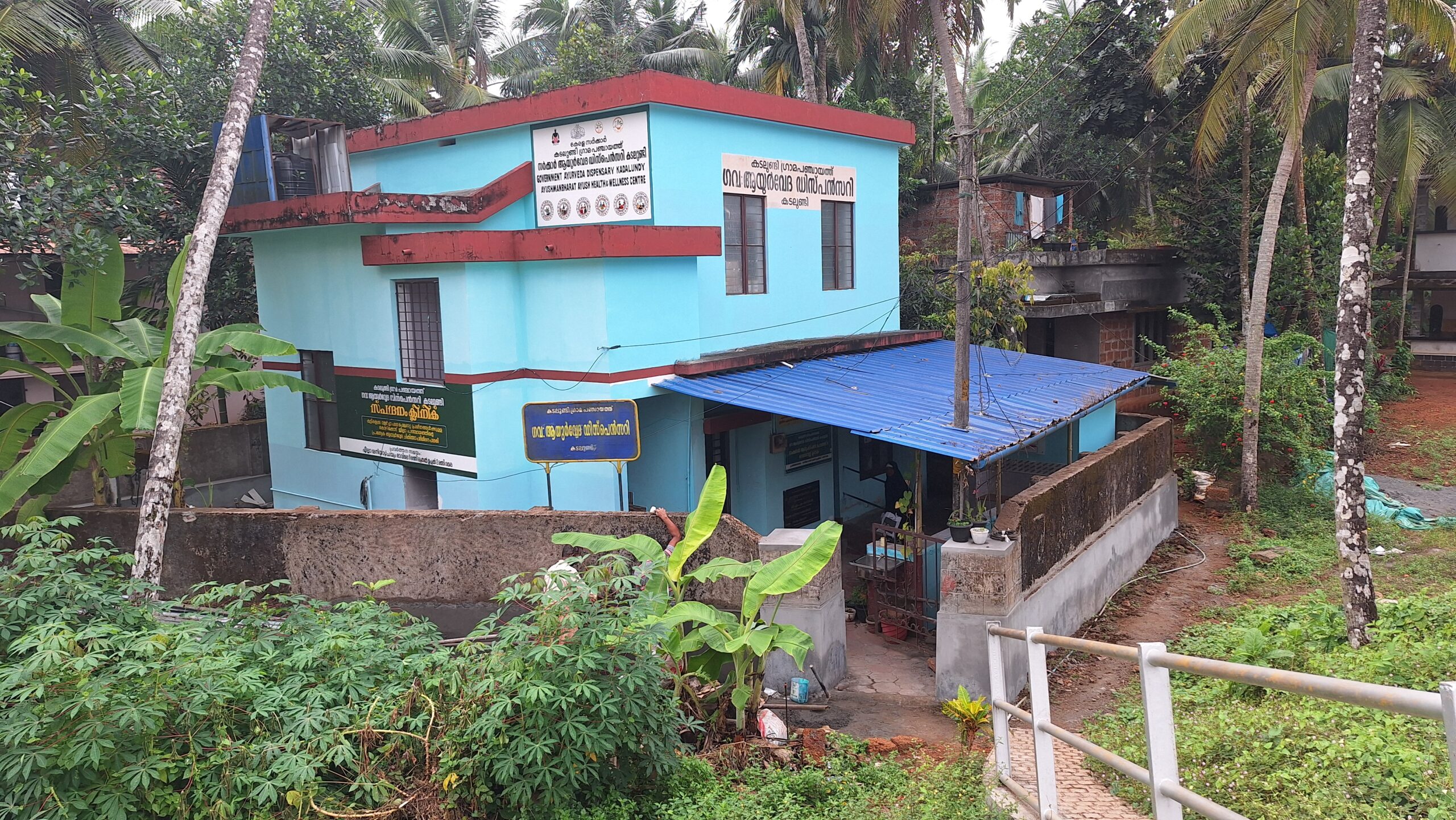
Calicut, “Kozhikode,” gave the rest of the world the heavy woven cotton cloth calico. I have visited Keralam at least seven times, both in the south near the capital Trivandrum, around Kochi, and near Kozhikode, which is where I was based at the beginning of this year. The names of the places have shifted, and still shift, contested, and spoken in different ways, with locals taking the train into the centre of the city usually referring to it as “kurrikod.”
A group of Western pilgrims on the way out to India during a stopover in Manama, capital of Bahrain, were intrigued by Keralam as one of the sources of spiritual energy; they were on their way to Hyderabad for a “Global Union of Scientists for Peace” mass gathering. This would, they hoped, enable them to concentrate their prayers in such a way as to resolve world conflict, a hopeful initiative that may yet bear fruit. Who knows. Meantime, real conflict is present in Keralam, local and international.
The Starbucks by the beach in Kozhikode, which was selling oat milk cappuccinos and lattes at western prices, had George Harrison’s “My Sweet Lord” playing for the customers. A small group of policemen had commandeered a side room with air conditioning, and they sat doing their paperwork. The day before, six students, activists of the Fraternity Movement, the student wing of the liberal “social justice” oriented Muslim rights-focused Welfare Party of India were arrested for putting up Palestine posters at the place. Yes, good work, we were told by a Communist Party member, but these kind of “sectionalist” politics tend to divide instead of unite the oppressed, the left; the Welfare Party has not been involved in the 2024 attempts to construct the “Indian National Developmental Inclusive Alliance” (INDIA) as a coalition of anti-BJP left forces in the Lok Sabha elections.
INDIA, which took 18 out of the 20 constituencies in Keralam, did much better than expected nationally against the BJP-run “National Democratic Alliance,” an alliance that Modi will now have to keep stitched together to rule. It did look at one point in the count as if the BJP may take the capital, Trivandrum, which would have been disastrous, but taking one constituency, Thrissur, is bad enough.
Keralam is one of the centres for “ayurvedic” medicine, an alternative to western medicine which is advertised not only to foreign tourists who want to go somewhere warm and green and, they are told, healthy, but also to Indians in other parts of the country. Inter-India tourism is a main driver of “development.” Ayurvedic health centres form part of Keralan local government health provision. We visited an ayurvedic health centre at Kadalundi, a small town on the coast south of Kozhikode, because my partner wanted advice on dealing with a bad cough and some other complaints. At the Kadalundi ayurvedic health centre, they were told they should register for 5 rupees, that is about 5 pence, and then, after a brief consultation, they were given a number of different remedies, potions and powders, no charge. This is a publicly available health service. Before we left, we had to pose for a selfie with the health centre staff.
We also visited an ayurvedic hospital about half an hour walk south of Kadalundi where there were inpatient facilities and massage. Kadalundi itself had no other Western tourists, and people would stop and talk to us strange specimens, mostly already knowing from their neighbours where we were from and whose place we were staying at.
So, Keralam is represented as the site of an exoticised “natural” medicine movement which draws on Hindu cosmology and operates alongside such practices as yoga, which is promoted by Modi and the BJP. The state is also seen by Delhi as a site of Islamic terrorism, represented as such not only by government ministers but also through mass media mobilisation. The latest instance of this is the film The Kerala Story released last year. Basically a film about religious indoctrination, there is a paradox that the film drums home its message, about Keralam as being the ideological and material base for Islamic State, in such a way as to appear itself to be a form of a religious indoctrination.
As the BJP began to sense that it would lose its own outright majority in the Lok Sabha in the 2024 elections, anti-Muslim rhetoric was hyped up in the last days of campaigning, with Modi claiming that Muslims, attacked for having large families, were “infiltrators.” The film is such a potent ideological representation of Keralam, toxic and useful for the right in India, that it is available online on YouTube, and then unpicked on more progressive Indian news sites.
Keralam carries the legacy of cultural-historical particularities which need to be borne in mind when considering the politics of the state, and the role the state now plays as a site of resistance to Modi-style neoliberalism. We will need to get to political organisation there later, but first let us look at how Keralam has represented itself to itself, historically and currently. I will do this by tracking three key cultural productions from 1889, 1856 and 2008, ones that are very well known and which carry with them powerful messages about what Keralam was and what it could be.
Indulekha

The first Malayalam novel, which was published in 1889, was Indulekha. It picks up and represents questions of colonialism, Western-style “Enlightenment,” and the position of women, questions still potent. The novel was written by a judge, O Chandu Menon, who was living in Parappanangadi, south of what was then Calicut, now a ten-minute train journey from Kadalundi. The story is set somewhere between Parappanangadi and Travancore, which is much further down south, much closer to the current capital Trivandrum.
The protagonist, a young women in her early twenties, Indulekha, has been educated in Sanskrit and English. Her boyfriend, Madhavan, is also educated, having graduated from the University of Madras, and has aspirations to work for the colonial administration as a civil servant. Indulekha is also, and this is the complication, being drawn into a marriage convenient to the patriarch of the family with an arrogant high-caste character, Suri Nambuthiri. This guy is part of the Nambudiri Brahmin ruling elite, humoured by the English and used as a relay point for colonial control.
There are a number of intriguing things about the novel. It put an educated young woman at the centre of the story, something which later commentators have linked to the matriarchal, if not proto-feminist cultural political atmosphere of the region. One of the male characters complains that “It is very true that here we men suffer untold misery from the freedom and opportunities which the women of Malabar enjoy for playing fast and loose with us and tormenting us.” This apparent freedom of women is, even so, limited, and Indulekha chafes against the restrictions placed on her, looking to the colonial masters as models of liberation: “Look at Europe and, America, where women share equally with men the advantages of education and enlightenment and liberty!”
Enlightenment is to the fore, with the opinion voiced that “the diffusion of knowledge is the greatest foe of profligacy and vice,” and there are jokes about knowledge of industrialisation, which is in the hands of the English, and to be desired, and local stupidity. A character comments that “lndulekha told me some things a few days ago about the railway train. She said that all machines of this kind are worked by the power of steam,” and there is speculation about what the machinery in one of the buildings is really for; perhaps, someone suggests, for decapitating the locals.
O Chandu Menon, the author, also relays the “novel” form into Malayalam culture, writing quite explicitly in his preface to the book that he wanted to write in the “English fashion.” This mimicking of English mores, and there are some side-plot references to English characters interested in buying land from the locals, includes visitors being offered tea and cake, and some of the conversation proceeding as if Indulekha is in a Jane Austen scene. We are told that Indulekha “had acquired the art of restraining her emotions and carrying them off lightly in her gestures.”
This “English fashion” causes the author some problems at some points in the novel, and he has to reassure the reader that the descriptions of the characters are not in line with his own opinions. So, when Suri Nambuthiri comes onto the scene, and is presented as a vain bumptious type, the novel suddenly switches narrative to make it clear that this does not mean that all high-caste types from around Travancore are like this: We are told that “In English novels the characters, male and female, are all drawn from various ranks of European society, and in some books even living celebrities are occasionally made the subject of censure, ridicule or praise.”
The novel also includes, in its first 1889 version, a very long conversation between some characters about the role and strategy of the Indian National Congress, which had been founded in 1885, just four years before Indulekha was published. This chapter, along with some other parts was cut in later editions, and then restored, the cuts and different versions reflecting changing contexts for possibilities of liberation from the English and debates over the role of women. The Congress debate chapter revolves around whether the English will have to be resisted or, the option favoured by the characters, and, it seems, by O Chandu Menon himself, whether there will be “a war of reason with the English.” The English, and, crucially, the English language, can be taken and used as an instrument of reason, for “the sympathy and concord which we now see prevailing throughout so vast a territory as India are really due to the English language,” and so “with the spread of knowledge, rigour of caste will be relaxed till in the end it disappears.”
Chemmeen
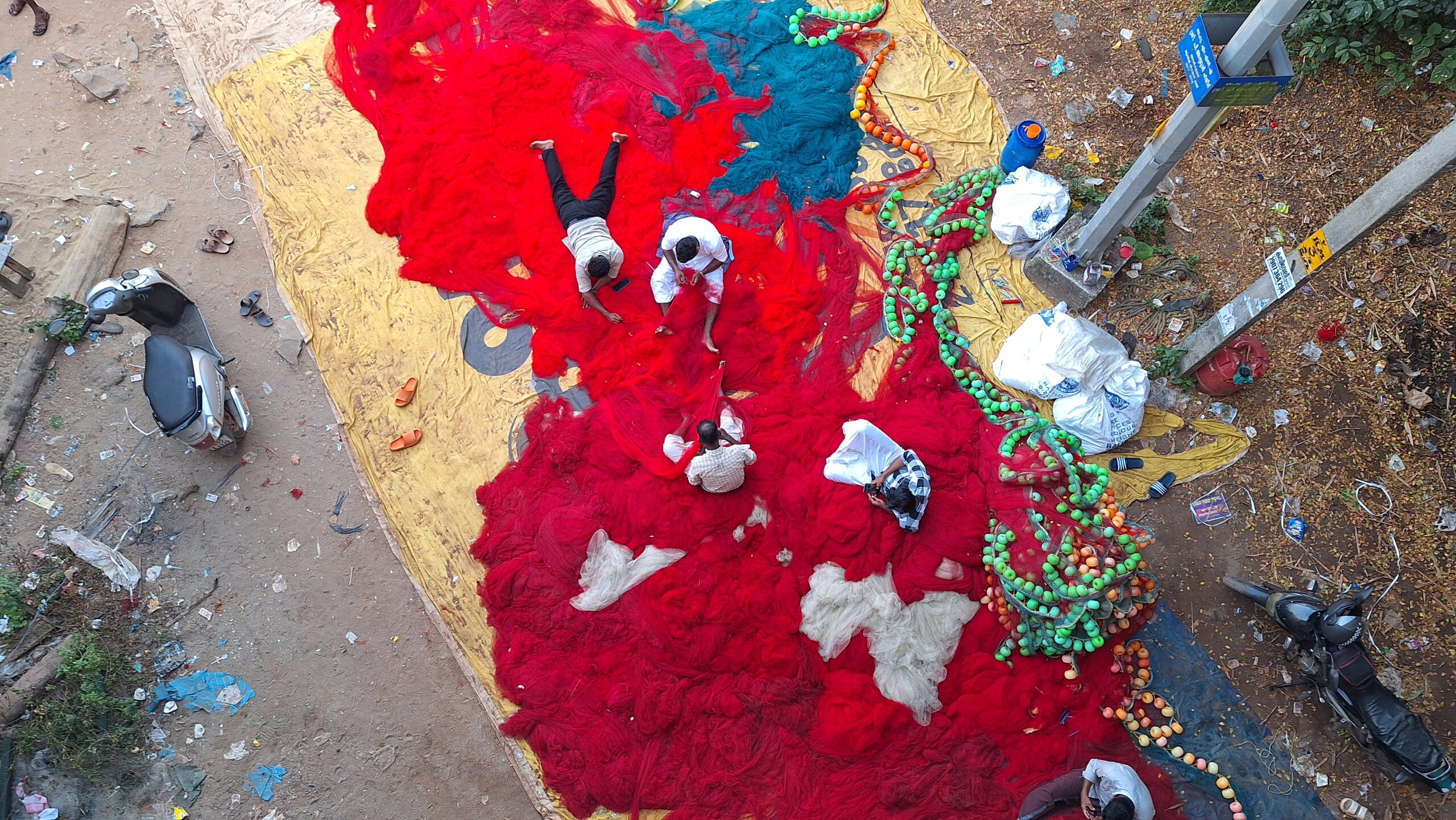
Fast forward nearly seventy years to the mid-fifties, after the British have left India, and after the brutal chaos of partition. Already Hinduism is being mobilised as a nation-building ideology. This “Hindutva,” nationalist ideology that Modi’s BJP is channelling today, is pitted against Muslims as the enemy, whether in Pakistan or locally, with Islamophobic racism targeting poor marginalised communities. Chemmeen, by Thakazhi Sivasankara Pillai is a still influential novel published in 1956, the year Keralam was founded as a state. A film adaptation was released ten years later. This book gives something of the local flavour of Hindutva.
The novel is about Karuthamma, who is the daughter of a fisherman, and her love for Pareekutty, the son of a fish wholesaler. The fishing community is Hindu, but this is never named as such in the novel. Fishing communities on the Malabar coast may often be Hindu, but there are Muslim fishing communities, as was the one nearby Kadalundi and in Parappanangadi, where mosques of different denominations lined the roads down to the sea and along the coast. Further down the coast around Travancore we had met with Syrian Christian fishermen on previous visits. The problem for Pareekutty is that this part of the coast is a “place fraught with dangerous temptations … And he was a Muslim” So, he is told quite directly “Child, you are a Muslim. And we are fisherfolk.”
The book riffs on old fisher-community tales of the role of women in guarding the home while the men are out to sea, and of the danger of that loyal care-taking role being broken, and so, as a consequence the man dying, and then the woman herself perishing. This is both a tragedy, then, but also the quite predictable reiteration of a message about what young woman in the community may and may not do. In this sense, Chemmeen stands as a counterpart to Indulekha, not only in terms of images of femininity – Karuthamma has little power to take decisions herself – but also class, for she has no independent resources, educational or otherwise, to be able to escape from her predicament. Instead, she is trapped. We are reassured that “Pareekutty had never sought to entice or seduce Karuthamma; he hadn’t even tried to.”
The book was a big success, winning a high-status literary prize in 1957, and was translated into over thirty languages. Significantly, given India’s economic-political links with the Soviet bloc, and more so the links between the ruling Communist Party in Keralam with sister parties in the Third International, the first translation was into Czech and then soon afterwards it was translated into Russian.
Also significant was the downplaying, in the Malayalam-language film version of Chemmeen, which is billed as a “romance,” of Pareekutty being Muslim, and also of all of the backwards and forwards of the consequences of her marrying him and converting that occupies so much of the novel. The question of caste, and of Pareekutty being excluded from the different castes that make up the fishing village, is also dealt with much less directly. Islam seems often to be tolerated in Keralam if it is turned into a form of art rather than religious practice threatening to culturally dominant Hinduism. By chance, for example, we hit upon an exhibition of Arabic calligraphy in metallic art at the Kerala Lalithakala Academy in the centre of Kozhikode. That did not pose a threat.
Goat Days
One of the most popular recent novels in Keralam is Goat Days first published in 2008, and into over hundred reprints. The author now lives in Bahrain, and the book is based on a true story, of a poor guy named “Najeeb” in the book, who leaves Keralam to work and send back remittances to his family. He is told that “you are going to a land where everything is available in plenty,” and his journey out of India opens up a vista of hopes and possibilities, “For me, Bombay was worry, Riyadh, wonder.”
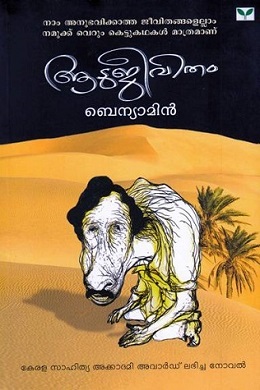
However, after arrangements and promises, Najeeb is going to be bitterly disappointed. He is collected at the airport and driven into the middle of nowhere to look after goats. There is no one else around other than his “arbab” or boss, who treats him cruelly, and who locks him into the compound in the middle of the desert.
There comes a point when Najeeb breaks down, and adapts to this terrible new life, and after nights of hunger and thirst is able to make good a first fake escape, an escape into this awful new life: “I slowly untied my legs and, creeping out through the goats, I reached the water container and drank till my thirst was quenched. In the next container, there were some wheat grains, left uneaten by the goats. I gathered them up and ate greedily. Raw wheat. Unhusked. There was some salt in the small pail nearby. I ate the wheat with the salt.”
And so, Najeeb is transformed into a migrant Gulf worker: “It was on that day I realised that uncooked wheat could be tasty! I guzzled water again from the container. My belly full, I was finally at ease. I slept in the masara with the goats. By then I had indeed become a goat.” It is only after some time living in these conditions that he is able, together with a fellow worker from a nearby compound, to really make a break for it while his arbab is away. After a long trek he makes it back to Riyadh, and collapses, by luck, in front of the “Malabar Restaurant,” and is nursed back to health by fellow Keralans.
Railway track workers at the small and most-times deserted Kadalundi train station told us, while taking selfies, of brothers and sisters working in construction in the Gulf states or, in one case, as a nurse near Manchester, in a town he could not remember the name of.
These three cultural productions, Indulekha from 1889, Chemmeen from 1956 and Goat Days from 2008, give some windows into the cultural context for the development of alternatives to the Indian state. We were told by our hosts that Delhi suffered “extreme temperatures” and was “unsafe,” but that does not mean that everything is hunky dory in Keralam, and we need to look in a little more detail at how the self-image of the state as being “progressive” or even “socialist,” the only one effectively still run by a “communist” party, matches up to reality.
Left Democratic Front
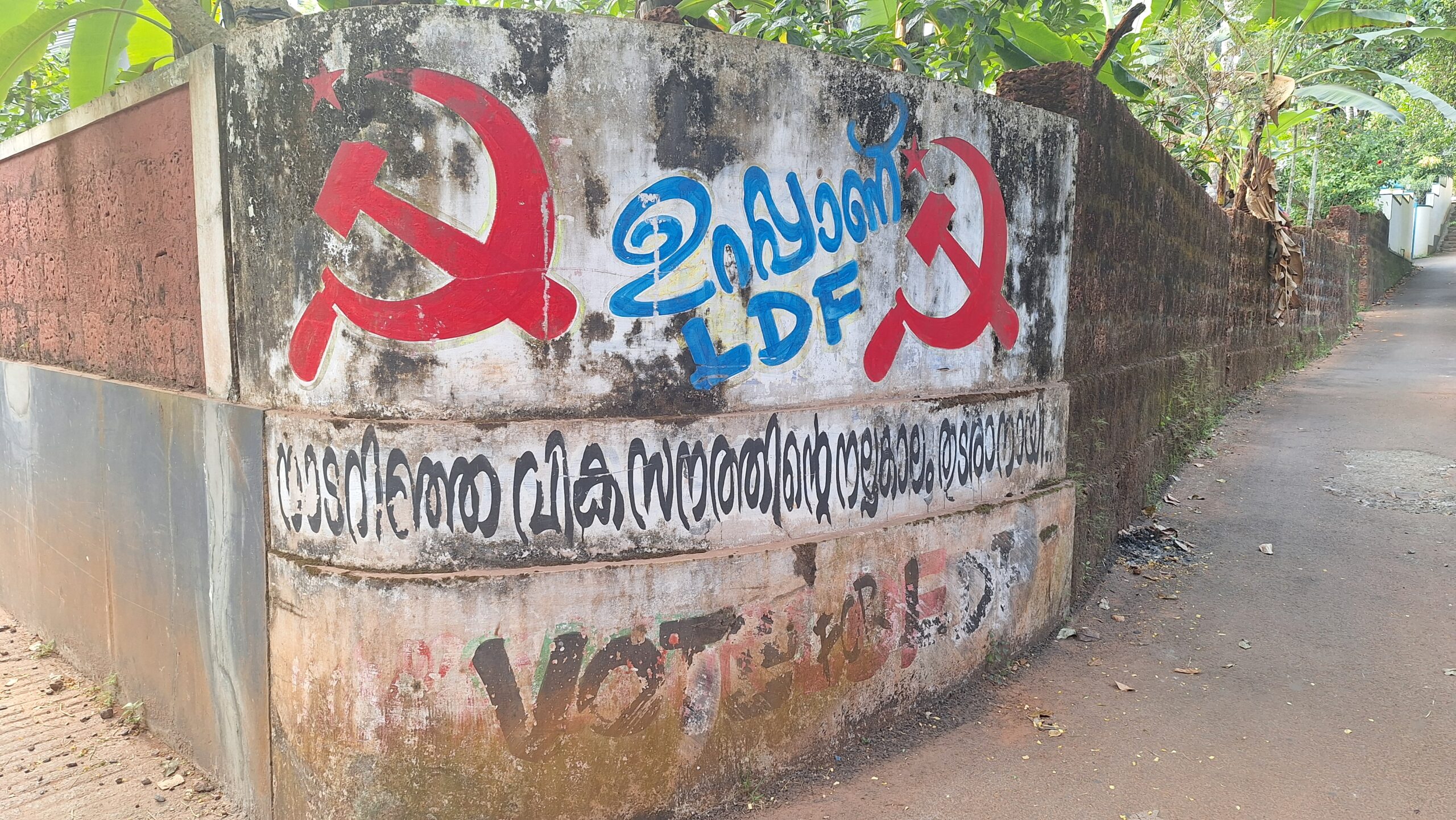
The left is organised in Keralam in the Left Democratic Front (LDF), in which the Communist Party of India (Marxist) (CPI-M) is the main force. The average vote for the left in Keralam has so far been roughly 45 per cent, just a crucial one percent edge over the main liberal opposition, the United Democratic Front (UDF) which stitches the Congress Party together locally with some other centre and leftish organisations. For the 2024 Lok Sabha elections, this electoral alliance became named “INDIA.”
An active part of the LDF is the Democratic Youth Federation of India (DYFI), a grouping founded in 1980 that is now the youth wing of the CPI(M). The upper age limit for membership of this “youth wing” of the party is 40. Outside the local DYFI offices on the road leading out of the small town of Kadalundi, there were images of Bhagat Singh, Che Guevara and Joseph Stalin. Bhagat Singh was a key figure in the Hindustan Socialist Republican Association (HRSA) after 1928, weirdly now someone claimed by the Modi-right outside Keralam as well as by the left in the state.
There is an enthusiastic detailed account of the work of the CPI(M) and the LDF by T M Thomas Isaac in his 2022 book Kerala: Another Possible World. He traces the success of communists in Keralam from their election a year after the foundation of the state within the federal Indian union in 1957, and he focuses on the “redistributive gains” and “successes in containing COVID,” (cases were reported as rising at the beginning of this year in India while still falling in Keralam, where lockdown measures during the pandemic were introduced earlier than in other Indian states), as well as combatting what he calls the “social virus of communalism.”
CPI(M)
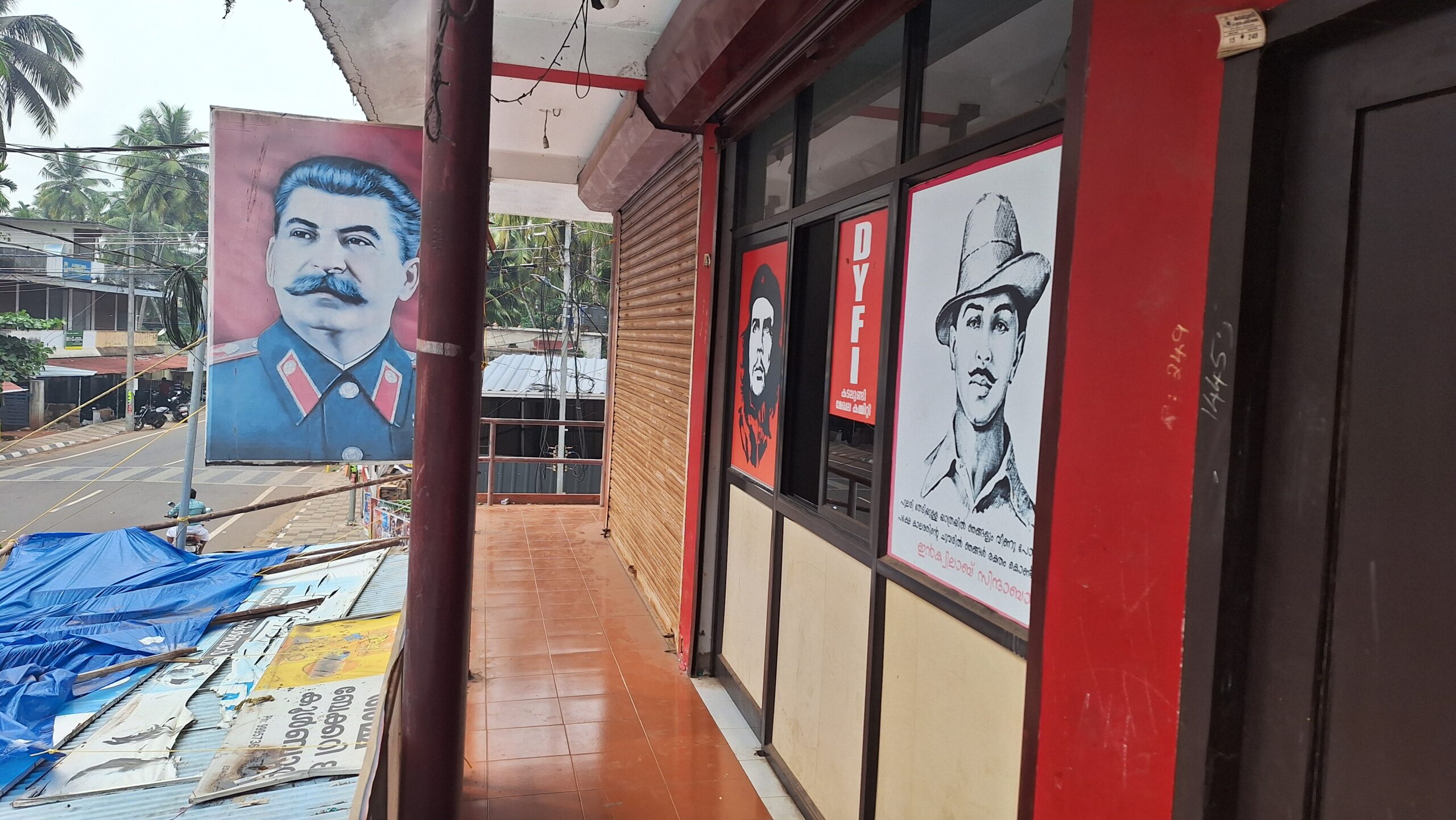
The historical roots of the CPI(M) lie in a conference of the Congress Socialist Party leaders of Malabar, held in secret in 1939, and then the eventual formation of the Communist Party of India (CPI) in Keralam. The CPI was the Third International local party, loyal to the Soviet Union and the various lines handed down by Stalin. In the first phase of the Second World War, we are told by Thomas Isaac that the CPI adopted “a line of unconditional resistance to the imperialist war.” A comrade in Keralam told us of the extreme pressure that communists were under after the Second World War, of her grandfather who was a member and who had to flee his house, which was then ransacked by police and copies of Marx’s Das Kapital destroyed.
The CPI(M) emerged from a split from the CPI in 1964, and so there were then two “communist” parties in India, one ostensibly pro-Soviet (the CPI) and one closer to China (the CPI-M). It may have broken from the CPI after the Sino-Soviet split, but this has not meant that the CPI(M) is particularly Maoist, or that there are major policy differences between the two parties. In fact, in the 2024 general election, there was a pact between the two parties, to stand as components of the broad INDIA coalition in the 20 Keralam constituencies (though the CPI unwisely broke that pact in some constituencies, including in Keralam). We can see the continued Stalinist orientation of the main LDF components in Thomas Isaac’s comment about the “deep respect they had developed towards the achievements of the Soviet Union”.
Moscow directed twists and turns, from alliance with bourgeois forces that were characterised as “progressive” to ultraleft opposition to any such alliances, depending on what Stalin was doing in Europe. This led to some difficulties for Keralan communists, as for their comrades in the rest of India. This is skated over in the book, with the rather cryptic comment that “The transition from unconditional opposition to unconditional support to the war efforts was a painful adjustment.”
Basically, the CPI, under orders from Moscow, had at one point been opposed to the “Quit India movement,” this in line with the criminal Stalinist policy of deferring national liberation until the battle for “democracy” against fascism was won, and this led to “wild accusations of the Congress leaders about the communists being the agents of the British.”
Thomas Isaac notes, without really being able to comprehend how this logically flowed from these twists and turns, that there was thus “created for the first time a generation of Leftists in Keralam who were anti-Communists,” a coded attack on revolutionary Marxists who refused to see Russia, and then China, as bastions of socialism. CPI(M) and CPI foreign policy is still campist, for example over Ukraine, something fuelled by the alliance of Modi with right-wing states, including Israel. Identification with the apparently “socialist states” was key to the Communist Party governance of Keralam for many years, with school textbooks in the 1950s being oriented to Russian and Chinese academic and literary resources. This is something we see in a two-way traffic of translation from the 1950s onwards, including the novel Chemmeen.
Religion, education and economic dependence
This contradictory situation created huge difficulties, we are told, in mobilising “working-class centres like Alleppey” and “poor fishermen of the catholic community.” These difficulties have intensified recently, for while the BJP has been striving to make inroads into Keralam through Hindu chauvinist “cultural” projects, mainly targeting Muslims, it has also been successful in making links with the Catholic Church hierarchy in Keralam, thus able to limit the appeal of the LDF. The LDF have, in return, alienated the church, rebutting attempts by a quite large and powerful “Syro-Malabar Archdiocese” – an organisation with a heritage back to Syrian Christian pilgrims arriving on the Malabar coast – to have itself recognised as “a religious institution of public nature” in some heavy-handed bureaucratic decision.
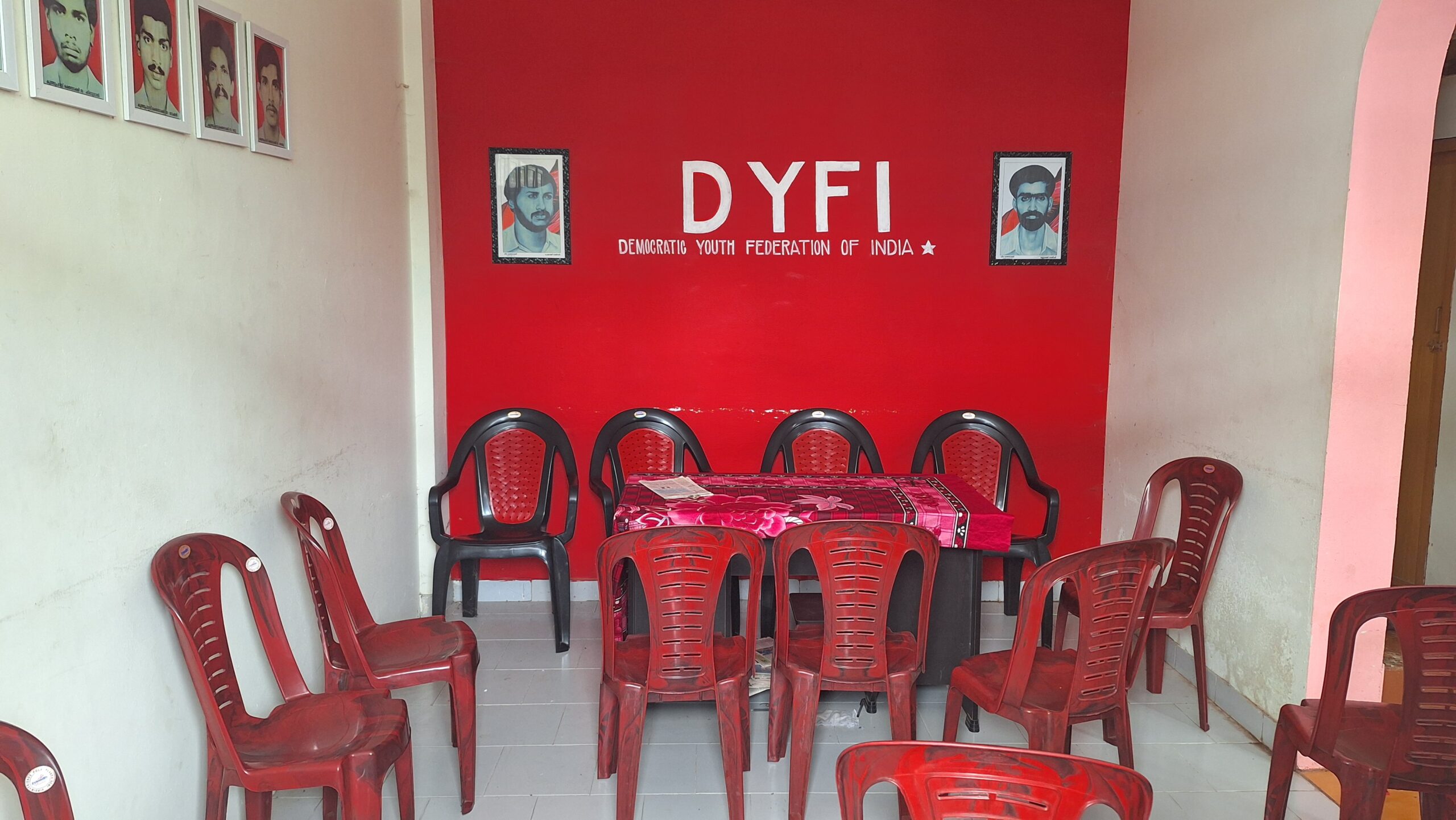
At the same time, there is a more radical history of involvement of Catholic activists that anticipate in some way liberation theology. There is a documentary, for example, called “Dialogues on Emancipation” that deals with the question of slave history in Northern Malabar, and the work of an Italian Priest, Peter Caiorni, who some saw as, in the words of the director who sent this link to me, “the subaltern ritualistic god of Theyyam.” Theyyam, which we had seen performances of on previous visits, is a Hindu-origin religious practice specific to the area.
Among policy successes have been that the police have been prohibited from interfering in labour disputes, and that there has been the implemented “universal and compulsory education within ten years,” something that Keralam is known for in India and beyond. There is thus the “spread of education and health facilities to northern Keralam, which lagged behind Travancore–Cochin.”
Institutes of Technology, though, have been jealously guarded as national government organisations, even in Keralam, we were told by some who worked in one there, so much so that they function, as the title of an academic book on them has it, “castes of merit,” which produce and regulate knowledge. These institutions ensure that caste privilege is maintained while making it, the author of the book claims, “invisible,” and so all the more effective. We heard from our friends there that radical ideas are marginalised, making for a difficult context for doing academic work that would connect with Keralan politics.
The attempt to build local resistance to national government as well as defend welfare services in Keralam is hindered by the national state controls on legislation and finance. For instance, “The Indian government’s 2003 Fiscal Responsibility and Budget Management (FRMB) Act imposed restrictions on public borrowing by the state government to 3 per cent of the Gross State Domestic Product (GSDP).” The problem of “centralisation” of the Indian state poses a problem, that the LDF “must work within the system while mobilising people,” and this requires the “successful application of the dialectical approach to problems of Kerala society.”
Thomas Isaac points to the particular role of remittances, mainly from the Gulf states, and the latest attempts to build on IT infrastructure following the decimation of Keralan agriculture, something that has been a consequence of corporate production and the outflow of labour from the state, mainly to the Gulf. This is something we see documented and worried over in the popular novel Goat Days. Average net migration to Gulf countries was, at the end of the 1970s, estimated to be around 70,000, but by the end of the 1980s this had increased to 500,000. There have been huge consequences of this for agricultural production: “Land was an important asset for investment by the migrants resulting in a boom in the land market and prices.”
State management
Here the LDF resorts to management within the constraints of national legislation and financial control; for instance, “The 2021–22 budget has unveiled a program for transformation to a knowledge economy,” something that builds on the “growth of a new middle class.”
Through all this, the LDF is confronted with the “dialectical” problem of how to manage a capitalist economy while declaring its intention to build socialism. It has, in fact, been difficult to square this circle, with some compromises over the years in terms of long-term goals that have been trimmed to short-term policy aims. For example, Thomas Isaac argues that “The false propaganda of Communist anarchy and violence created a mental block to investors to come to Keralam even though Keralam has been below the national average for the last four decades by all indicators of industrial strikes.”
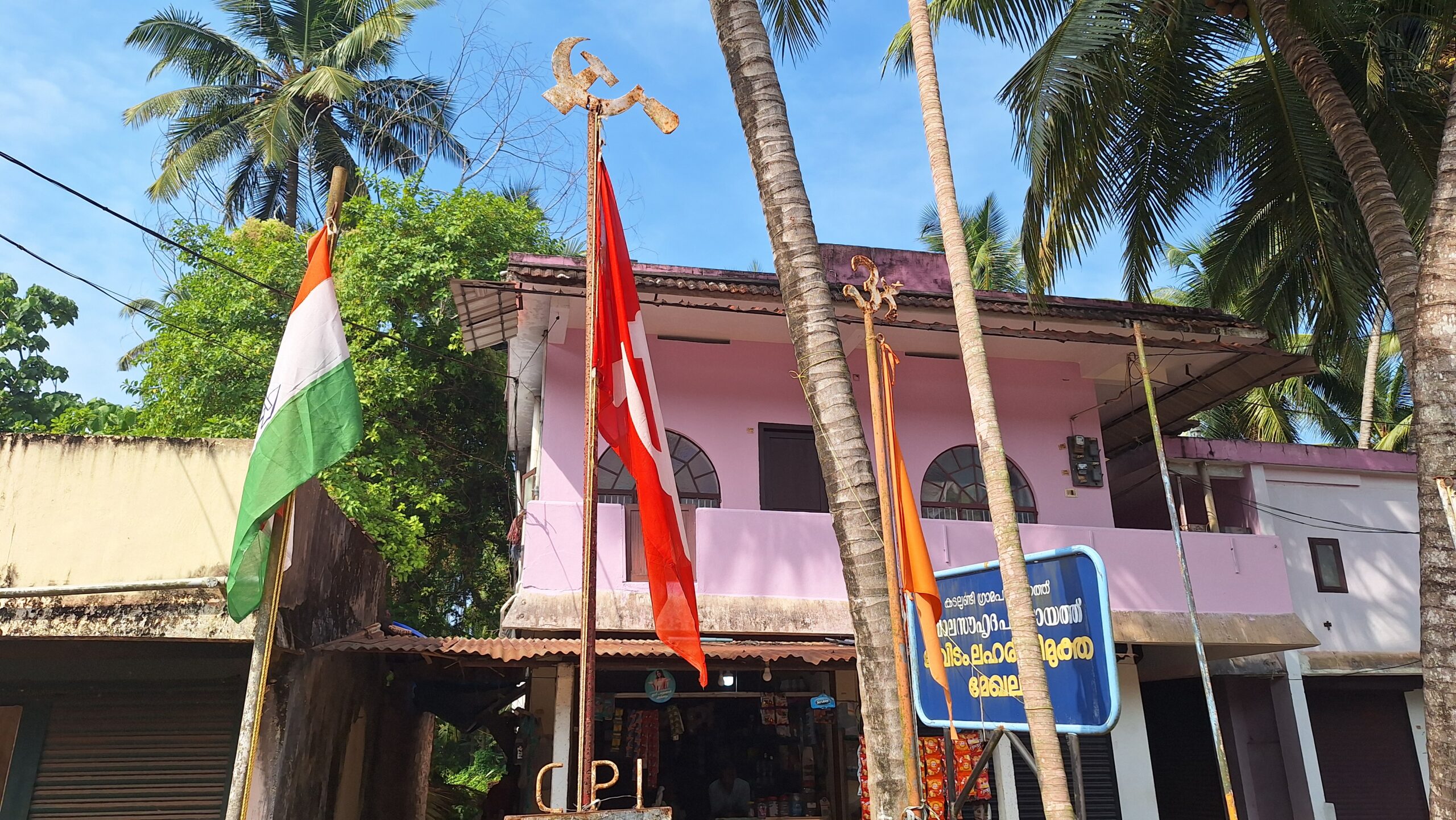
The CPI(M) record of defence of what Thomas Isaac calls the “minority communities” – 27 per cent Muslims and 18 per cent Christians – has, according to some comrades, including those who are members of the CPI(M), been rather mixed. On the one hand, the CPI(M) has been active around specific cases of discrimination, supported their Muslim members and opposed attacks on the community, but on the other hand, we were told, the party does not issue general directives about or complaints against Islamophobia.
Their eyes are on class blocs that can be mobilised in elections, and so it is noted that “the vote share of the Left is highest among scheduled castes (63 per cent) and then among backward [sic] castes, particularly Ezhavas (53 per cent).” The Ezhavas are the specific local Hindu community of Keralam, treated by the British as being the same rank as other groups, but historically always claiming higher caste status. In contrast, the LDF vote “has been relatively much lower at around 29 per cent among the Christians and 31 per cent among Muslims.”
So, the LDF relies on a “redistributive development strategy,” struggling in the context of a “relatively low level of economic development when compared to the rest of India,” and acknowledgement that “Underemployment in the state is the highest in the country.” So, this is a “left” that relies on “Public-Private Partnerships” in order to bring in private investment, and the neoliberal policy apparatus of “Knowledge Hubs, Industrial Parks, Amusement Centres, and Townships” are touted as salvation.
Participation, the care economy and ecology
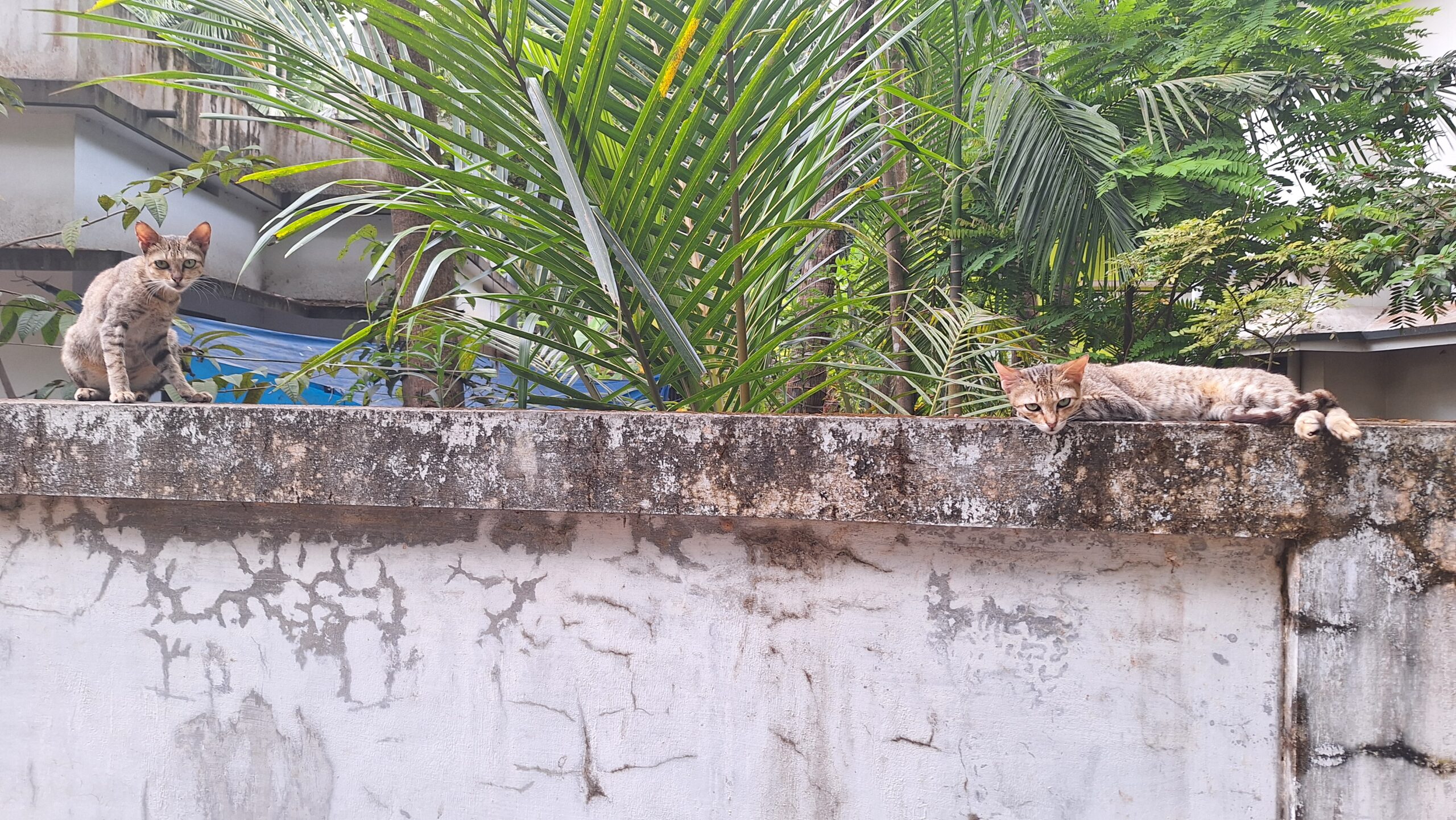
There is talk among LDF policy makers of “participatory budgets,” and the transition to a “care economy,” but this is subject to the imperatives of economic growth, and Keralam already has one of the highest densities of cars on the roads of the whole of India.
The rapid concreting of swathes of land is a concern for ecological activists, of course. One led me round an area of land up above their house north of Kozhikode and warned me to look out for snakes, adding that this was not a serious risk because our footfall would warn them to keep away from us. One of the problems with concretisation of the ground is that snakes do not have ground cover to retreat to, and so, with rising temperatures, they instead seek refuge inside houses. They are also less able to detect the very distinctive vibrations of those who are walking near to them. The ground as a medium for communication is being destroyed, with consequences both for the snakes and for human beings sharing the planet with them.
The Keralam state assembly passed a resolution in 2020, with the one BJP representative voting against, to withdraw the new Farm Laws, and although the movement in Keralam itself has not been strong, with the centre of protests being up in the north, there has been some material support for the protests, and mobilisation against them by the LDF. (There was some impact of farmer protests in Punjab, Haryana, UP and Rajasthan, where Congress saw a massive surge in the 2024 elections).
These are battles on a terrain they did not choose but have adapted to. It is acknowledged, for example, that “male unemployment rate in Keralam is 5.8 per cent, the female unemployment rate is 19.1 per cent,” but there has been little progress in levelling power inequalities. I was told by comrades active in the CPI(M) in Keralam that there were attempts to bring younger women comrades, and Muslim activists, into higher positions in the party, but this was a very slow process, and these comrades, as well as some who still supported the CPI, complained that the higher levels of the party were still dominated by old men. Here there are legacies of women’s self-organisation that aim to reclaim and deepen the “enlightenment” concern with women’s rights that was showcased back in the 1889 novel Indulekha.
The old men are the figures who appear on campaign literature, and who make the decisions, and whose squabbles internally, and with their erstwhile comrades in the CPI, constitute the main political battleground of their hold on power. Thomas Isaac himself, who, to be fair, would be counted among the “old men,” notes, with approval, that while “democratic centralisation” is inappropriate at the level of state economic organisation, it does provide the guiding framework for running the CPI(M) apparatus.
The BJP in Keralam
Thomas Isaac argues in his defence of the LDF that “the Left has made an effort to appreciate the nature of the religiosity among the Christians and the Muslims,” but the BJP has been making inroads in Keralam, something that they have been wanting to bear fruit in the 2024 election. Their success was unexpected, and down to what one CPI(M) comrade described as a “grave miscalculation;” the CPI was so sure that the INDIA coalition would take Thrissur that it also stood its own candidate against the INC and the BJP, so splitting the vote and letting a Malayalam film star to take the seat for the BJP, a disastrous first Lok Sabha seat for Modi. The CPI(M)-led INDIA coalition in Keralam was intent on stopping Modi, so much so that it backed Rahul Gandhi standing for Congress in the Wayanad constituency; Gandhi did take that seat (and also another seat in Uttar Pradesh).
An online open-access article by Dayal Paleri last year in Modern Asian Studies called “Elections can wait: The politics of constructing a ‘Hindu atmosphere’ in Kerala, South India” paints a gloomy picture of the intensive work of the BJP to advance “Hindutva” in the state. Whatever successes the BJP had in the 2024 elections pale to nothing in the face of the ongoing production of exactly the “communalist” tensions that the LDF fears. The Paleri article focuses on Kodungallur, about 20 miles north of Kochi, to show how the BJP is advancing the ”vernacularization of Hindutva”, that is, the embedding of Hindutva culture in the locale as the basis for a reactionary mobilisation against Muslims. This is an “everyday Hindutva” that is being produced through the “organizational network of the Sangh,” local assembly or congregation.

The cultural-political context that the BJP is quite aware of, and this will be no surprise to followers of the LDF, is that “The politics, religion, and culture of Kerala are more influenced by ideologies from Russia, Gulf or the West, than of India.” It is that left culture, according to the Hindutva right, that must be subverted in order to build support for the national government, for Modi’s BJP.
Kodungallur is significant for Paleri’s ethnographic study because “Historically, Kodungallur is known as the ‘cradle of religious diversity’ in India, as most religious communities trace the origins of their remembered past to Kodungallur.” The insidious and well-organised Hindutva movement has been focusing on the local temple, with the Kerala Kshetra Samrakshana Samithi (Temple Protection Council of Kerala) (KKSS) arguing that the temple is not “public property.” As a consequence, there has been an exclusion of people from the temple area, and eventually, a success for the right; “public events were gradually shifted to a ground near the Kodungallur police station, owned by the revenue department of the Kerala government.”
Hindutva activists will argue that “the practice of yoga is the best way to keep the national body pure, clear of maladies like ‘cultural nihilism’.” Vivekananda Vedic Vision Kendra (VK) has been active in this process, and so “The VK’s activities are aimed at transforming the subjectivity of individuals in Kodungallur, mainly through yoga, spiritual education through routine study circles, residential camps, social service activities, and self-help groups, with an overarching focus on family as the primary site of the activities.”
In this way “The activities of the VK directly reinforce the idea of gendered patriarchal families as the bedrock of Hindu cultural awakening.” And, returning to the question of male and female unemployment in Keralam, the activists building a “Hindutva atmosphere” and the cultural and political base for a local Modi-led assault on Keralan socialism, are able to mobilise women: “Spiritually awakened women are presented as the embodiment of patience and sacrifice and the bearer of traditional virtues.”
The CPI(M), as a function of its bureaucratic and centralised approach to politics, has, according to Paleri, fallen into the trap, and its recent attempts to engage with temple affairs has been through state-controlled boards. There is a stark warning here, not only for Muslims in Keralam, but for the whole of the left, for the Keralam “socialist” experiment itself, for, as Paleri argues in the conclusion of her ethnographic study, “Thiruvallur, once known as ‘Moscow’ for being the birthplace of the Communist Party in Kodungallur, is today a site of active efforts to construct a Hindu nationalist community through ‘silent and routine’ forms of engagement.”
Return
The day we left India for Qatar, there was a massive mobilisation by Modi and the BJP apparatus around the inauguration of the Ram Hindu temple at Ayodhya, a temple built triumphally on the site of the Babri Masjid. This original mosque, founded in 1527, was the site of anti-Muslim riots in 1992 when the mosque was torn down. The inauguration was, of course, condemned by the left as an obvious Islamophobic provocation. A Muslim friend had to travel back from Keralam to her home in Andhra Pradesh that same day, and she was very nervous to be doing so. While Hindutva activists celebrated on the streets, this was a time of danger, potential for the one of the many lynching outbreaks that has been occurring on an increasingly regular basis in recent years, with Islamophobic panic about so-called “love jihad,” the supposed attempt by Muslim men to convert Hindu women.
The Qatar English-language daily newspaper News Trail was playing it both ways in its 24 January coverage of the Ram Temple inauguration in coverage designed to appeal to both Hindu and Muslim migrant readers. One inside page headline warned that the inauguration sets a “dangerous precedent,” while another story ominously described the event “as significant as Aug 15, 1947.” Another report in the paper from Keralam was about the dangers of the temple inauguration to secularism in the state. It is perhaps a little comfort that in the 2024 Lok Sabha elections, Ayodhya was lost by BJP to a Dalit candidate from INC, and Modi needs to keep the other parties in his “National Democratic Alliance” onside in order to rule in a third term of office. An “open letter” I was sent the link for is among many attempts to frustrate this.
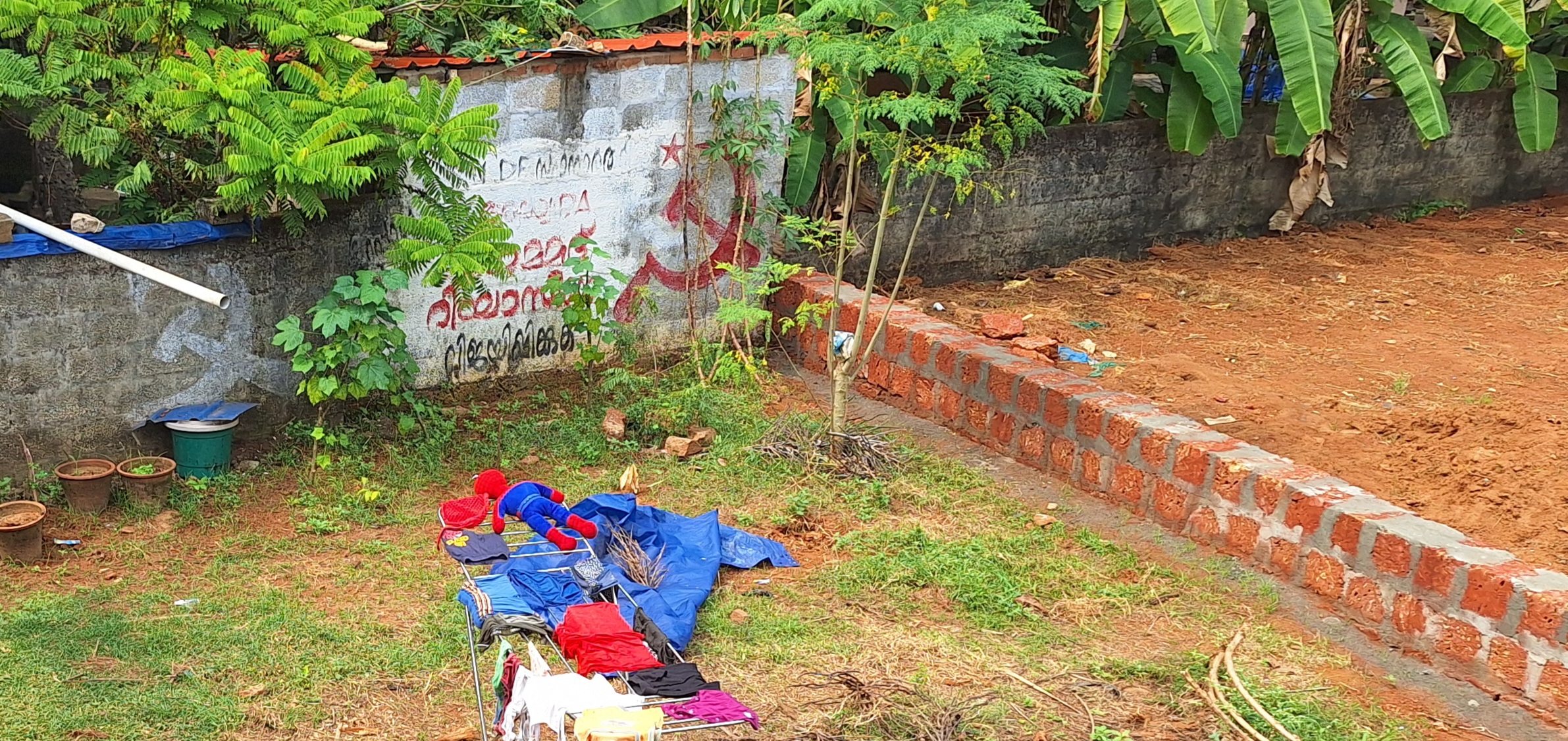
The taxi driver who took us from the airport in Doha, capital of Qatar, to our hotel, was delighted that we had come from Keralam – “my country” he said – but he had left his country, as many drivers we met there had, on a two-year yet very precarious contract. He was one of the many there who are sending back their remittances to support what presents itself as socialism on the southern tip of India, but which is, if it is not yet socialism, is an island of hope, limited imperfect hope that things could be different.
This account is, of course, a partial view, limited by the people I spoke to in only one part of Keralam; other parts of the state I have visited in the past have changed quite rapidly. These comrades were, in the main, on the left, either members of or close to the CPI(M), and so mostly quite loyal to the project of attempting to hold ground in Keralam while building the possibilities for socialism across India, though one comrade, not in the CPI(M) commented, after the election, that the CPI(M) needed to look in the mirror and examine how its management of the state and electoral strategy departed from the Marxist texts they claim to follow in their education classes. For all of its problems and top-down administration, and unlike in many other “socialisms,” young women comrades and those involved in LGBTQIA+ politics are finding ways of engaging in collective action that does build spaces for an alternative, another world, so that socialism in Keralam, a really socialist Keralam can become actualised.
Art (54) Book Review (127) Books (114) Capitalism (68) China (81) Climate Emergency (99) Conservative Government (90) Conservative Party (45) COVID-19 (45) EcoSocialism (58) Elections (83) Europe (46) Fascism (61) Film (49) Film Review (68) France (72) Gaza (62) Imperialism (100) Israel (129) Italy (46) Keir Starmer (56) Labour Party (114) Long Read (42) Marxism (50) Marxist Theory (48) Palestine (179) pandemic (78) Protest (154) Russia (341) Solidarity (146) Statement (49) Trade Unionism (142) Ukraine (349) United States of America (134) War (369)

